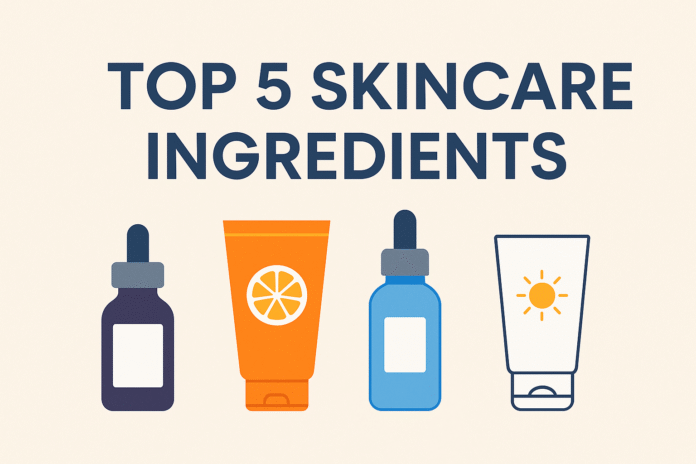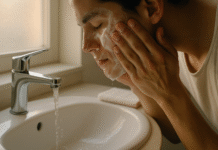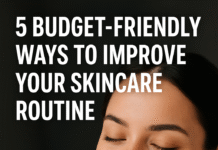If you care about skin that looks healthy, resilient, and radiantly you — not just “beauty theater” — this guide is for you. In the first 100 words: this article unpacks the top 5 skincare ingredients to look for in products (what they do, how to use them, safety tips, and simple plans) so you can choose formulas that actually deliver results. Expect clear how-tos, beginner-friendly routines, troubleshooting, and a 4-week starter roadmap to put these ingredients to work.
Medical disclaimer: this article offers evidence-based, practical skincare guidance, but it does not replace personalized medical advice. If you have active skin disease, are pregnant or breastfeeding, or have special medical concerns, consult a qualified healthcare professional before starting new topical treatments.
Key takeaways
- Retinoids, vitamin C, hyaluronic acid, niacinamide, and sunscreen are the five ingredients with the strongest practical impact across aging, hydration, tone, and sun protection.
- Use sunscreen daily as the foundation of any effective routine; the other actives boost repair, hydration, and tone but don’t replace UV protection.
- Start low and slow: begin retinoids and strong actives at low frequency and concentration, increase gradually, and track skin response.
- Pairing ingredients sensibly (e.g., vitamin C in the morning, retinol at night; hyaluronic acid as a hydrator underneath serums) improves results and reduces irritation.
- A simple, consistent routine used for 8–12 weeks is where measurable improvements appear — be patient, and measure hydration, texture, and pigmentation changes.
Why these five? (short primer)
Choosing what to put on your skin should be a balance of proof, tolerability, and real-world benefit. The five ingredients covered here were selected because they:
- Have reproducible clinical evidence for improving hydration, tone, texture, or preventing UV damage.
- Complement each other in a routine rather than duplicate the same narrow effect.
- Are widely available at multiple price points and in many formulations (serums, creams, sunscreens, gels).
Now let’s walk through each ingredient in depth — what it is, why it matters, how to use it, safety, and a tiny sample routine you can try tonight.
Retinoids (retinol, tretinoin, adapalene)
What it is and core benefits
Retinoids are vitamin A–derived compounds applied topically that accelerate skin cell turnover and stimulate collagen production. They’re the go-to active for smoothing fine lines, improving texture, fading post-inflammatory pigmentation, and managing acneiform breakouts.
Clinical data shows topical retinoids improve visible signs of photoaging, increase skin thickness, and reduce fine wrinkles over months of consistent use.
Requirements / prerequisites and low-cost alternatives
Requirements:
- A source product (OTC retinol or prescription retinoid like tretinoin/adapalene).
- Patience and sunscreen (must be used daily while using retinoids).
- A basic moisturizer to manage dryness and irritation.
Low-cost alternatives:
- If retinoids are not tolerated, consider bakuchiol (a plant-derived retinol alternative) or use non-retinoid exfoliants (like low-strength alpha hydroxy acids) to encourage cell turnover.
- For pregnant or trying-to-conceive individuals, avoid retinoids and use niacinamide and azelaic acid instead.
Step-by-step instructions for a beginner
- Start with a gentle cleanser and dry your skin thoroughly.
- Week 1–2: Apply a pea-sized amount of a low-strength retinol (e.g., 0.25–0.3%) two nights a week (e.g., Tuesday & Saturday), after cleansing and before moisturizer.
- Weeks 3–4: If no significant irritation, increase to every other night.
- Months 2–3: Gradually increase to nightly use as tolerated and/or move to a stronger formulation (e.g., 0.5–1% retinol) or consult for a prescription if needed.
- Always follow with a moisturizer if you experience flaking or tightness.
Beginner modifications and progressions
- Simplify: Use “retinol sandwich” — moisturizer → retinol → moisturizer — to buffer irritation.
- Progress: Once your skin tolerates nightly low-strength retinol (6–12 weeks), you may increase frequency or strength, or switch to a prescription retinoid under provider guidance.
- Downgrade: If irritation persists, reduce frequency back to 1–2 times/week.
Recommended frequency / duration / metrics
- Frequency: Start 1–2 nights/week → progress to nightly over several months.
- Duration: Expect visible improvements in texture/pore size in 8–12 weeks, deeper lines/firmness in 6–12 months.
- Metrics: Track tolerance (redness/flaking), hydration, and visible changes in fine lines and hyperpigmentation via photos every 4 weeks.
Safety, caveats, and common mistakes
- Sun sensitivity: Retinoids can increase sun sensitivity; always use daily broad-spectrum sunscreen and wear protective clothing.
- Pregnancy: Topical retinoids are generally advised against during pregnancy or when trying to conceive.
- Irritation risk: Redness, dryness, and peeling are common early effects. Over-application or using strong retinoids without acclimation causes setbacks.
- Mixing mistakes: Avoid combining potent exfoliants and retinoids in the same session unless advised — alternate instead.
Mini-plan (2–3 steps)
- Cleanse, pat skin dry.
- Apply pea-sized retinol to face every third night for the first two weeks.
- Follow with a gentle moisturizer. Use SPF every morning.
Vitamin C (L-ascorbic acid and stabilized derivatives)
What it is and core benefits
Vitamin C is an antioxidant that neutralizes free radicals, supports collagen synthesis, and helps brighten skin tone by inhibiting pathways that lead to hyperpigmentation. Topically delivered vitamin C can improve skin radiance, reduce photodamage, and enhance the effects of sunscreen.
Certain concentrations and stable formulations are needed for reliable results.
Requirements / prerequisites and low-cost alternatives
Requirements:
- A stable formulation (look for airtight, opaque packaging).
- Appropriate concentration (see below) and correct pH in some formulations.
- Sunscreen to pair with antioxidant protection.
Low-cost alternatives:
- Derivatives such as magnesium ascorbyl phosphate or sodium ascorbyl phosphate are more stable and gentler for sensitive skin, though they may be less potent per molecule.
- A diet rich in vitamin C supports overall collagen health but does not replace topical effects.
Step-by-step instructions for a beginner
- Morning application: After cleansing and toning, apply a few drops of vitamin C serum to slightly damp skin.
- Wait 30–60 seconds for absorption.
- Follow with hyaluronic acid (optional), moisturizer, and daily sunscreen.
- If starting with a fresh product, patch test behind the ear or on the inner forearm for 48 hours.
Beginner modifications and progressions
- Start gentle: Use a low-concentration vitamin C derivative (5–10%) if you have sensitive skin.
- Scale up: Move to L-ascorbic acid at 10–20% once your skin tolerates lower strength.
- Combine wisely: Pair vitamin C with hydrating serums (hyaluronic acid) and niacinamide or peptides for complementary benefits.
Recommended frequency / duration / metrics
- Frequency: Daily in the morning for best antioxidant benefit.
- Duration: Visible brightening and improved radiance often reported at 8–12 weeks.
- Metrics: Photograph before starting, then every 4 weeks to monitor reduction in brown spots and general radiance.
Safety, caveats, and common mistakes
- Stability: Vitamin C can oxidize and turn brown; when degraded it may be less effective or irritating. Choose stable packaging.
- Concentration myths: Higher concentration is not always better — efficacy often peaks around the mid-teens (10–20%) for L-ascorbic acid, but formulation stability and skin tolerance matter more.
- Irritation: People with rosacea or very sensitive skin may find L-ascorbic acid irritating; derivatives or lower concentrations help.
- Mixing with strong benzoyl peroxide: May oxidize vitamin C and reduce benefit — space them out or use at different times of day.
Mini-plan (2–3 steps)
- AM: Cleanse → Vitamin C serum (3–5 drops) → hyaluronic acid (if used) → moisturizer → SPF 30+.
- Repeat every morning; replace product if color darkens.
Hyaluronic Acid (HA)
What it is and core benefits
Hyaluronic acid is a naturally occurring sugar molecule that binds and holds water. Topical HA hydrates the skin, plumps superficial lines, and improves texture and skin feel. Different molecular weights can influence surface-level vs deeper hydration.
Clinical studies show topical HA serums can significantly increase measurable skin hydration and improve visible plumpness.
Requirements / prerequisites and low-cost alternatives
Requirements:
- A serum or moisturizer containing hyaluronic acid specified on the label.
- Ideally, apply to damp skin and lock in moisture with a moisturizer.
Low-cost alternatives:
- Glycerin or propanediol are humectants that also pull water into the skin and are commonly used in affordable hydrators.
- Occlusives (petrolatum, dimethicone) can lock in moisture if humectants alone are insufficient.
Step-by-step instructions for a beginner
- After cleansing, while skin is slightly damp, apply a pea-sized amount of an HA serum.
- Allow it to absorb for 30 seconds.
- Apply moisturizer to trap hydration and prevent transepidermal water loss.
Beginner modifications and progressions
- Simplify: If in a dry climate, use HA once daily under a heavier moisturizer.
- Progress: Combine low and high molecular weight HA formulas for both surface plumping and better penetration.
- Avoid overuse: In very low humidity, HA can pull ambient moisture from deeper layers and feel drying — counter with an occlusive moisturizer.
Recommended frequency / duration / metrics
- Frequency: Twice daily or once daily depending on dryness and product tolerance.
- Duration: Immediate hydration is seen; structural improvements in skin smoothness can be noticed within 2–6 weeks.
- Metrics: Measure skin feel, reduced fine-line depth visually, or use measurement devices for corneometry in clinical settings.
Safety, caveats, and common mistakes
- Application environment: Using HA in arid environments without an occlusive moisturizer can be counterproductive.
- Layering: HA works best as part of a routine that includes moisturizers and sunscreen; don’t expect it to repair barrier damage alone.
- Overstated claims: HA plumps superficially but won’t replace lost structural collagen on its own.
Mini-plan (2–3 steps)
- PM & AM: Cleanse → apply HA to damp skin → moisturizer → sunscreen in the AM.
- Use nightly if skin feels particularly dehydrated.
Niacinamide (vitamin B3)
What it is and core benefits
Niacinamide is a versatile, water-soluble form of vitamin B3 that increases production of barrier lipids, reduces inflammation, modulates sebum, and helps reduce hyperpigmentation by interfering with melanosome transfer. It’s widely used for sensitive, acne-prone, and mature skin types.
Clinical trials demonstrate benefits at commonly used concentrations for sebum control, pigmentation reduction, and barrier repair.
Requirements / prerequisites and low-cost alternatives
Requirements:
- A niacinamide serum or product containing a clear listed percentage.
- Patch testing if you’re sensitive.
Low-cost alternatives:
- Azelaic acid can also reduce redness and pigmentation and is sometimes recommended when niacinamide is not tolerated.
- Ceramide-rich moisturizers support barrier repair if barrier building is the primary goal.
Step-by-step instructions for a beginner
- After cleansing, apply a niacinamide serum (usually a few drops) to the whole face.
- Follow with moisturizer and sunscreen in the AM.
- Niacinamide is usually well tolerated enough for twice-daily use.
Beginner modifications and progressions
- Start low: Begin with products in the 2–5% range. Many clinical studies use 4%.
- Scale up: If tolerated and needed for pigmentation, some formulas go up to 10%; higher concentrations are not necessarily more effective.
- Alternate: If combining with very acidic exfoliants, consider alternating or waiting a short interval.
Recommended frequency / duration / metrics
- Frequency: Twice daily is commonly recommended for maintenance.
- Duration: Expect measurable changes in pigmentation and sebum regulation at 8–12 weeks.
- Metrics: Track oiliness, pore appearance, and lightening of dark spots via photos.
Safety, caveats, and common mistakes
- Too much of a good thing: Very high concentrations can cause irritation in some people; most studies use 2–5% or 4%.
- Mixing myths: Niacinamide is compatible with many actives; prior concerns about neutralizing vitamin C are largely outdated under normal product use conditions.
- Formulation matters: Look for clear labeling and stable formulations.
Mini-plan (2–3 steps)
- AM & PM: Cleanse → niacinamide serum (2–5%) → moisturizer → sunscreen in AM.
- For oily skin, use twice daily; for sensitive skin, start once daily.
Sunscreen (broad-spectrum SPF active — mineral or chemical)
What it is and core benefits
Sunscreen is the single most effective over-the-counter intervention to prevent UV-driven skin damage, photoaging, and reduce the long-term risk of certain skin cancers. Effective sunscreens contain ingredients that either absorb UV radiation or physically block/reflect it.
Randomized and long-term studies show sunscreen use reduces risk of certain skin cancers and photoaging changes.
Requirements / prerequisites and low-cost alternatives
Requirements:
- A broad-spectrum sunscreen with at least SPF 30 and water resistance if needed.
- Reapplication every two hours during sun exposure, and immediately after swimming or heavy sweating.
Low-cost alternatives:
- Protective clothing, hats, and shade are low-cost and highly effective complements to sunscreen.
- Mineral sunscreens (zinc oxide, titanium dioxide) are often recommended for sensitive skin.
Step-by-step instructions for a beginner
- Morning final step: After your moisturizer (and after antioxidant serum like vitamin C), apply a generous layer of sunscreen — enough to cover face and neck (about a nickel to quarter sized for the face).
- Reapply every two hours outdoors and after swimming/sweating.
- Use a lip balm with SPF for lip protection.
Beginner modifications and progressions
- Daily habit: Even on cloudy days, apply SPF as the final morning step.
- Layering: Use sunglasses and hats for extra protection.
- Progress: If you’re outdoors all day, consider combination strategies (sunscreen + UPF clothing).
Recommended frequency / duration / metrics
- Frequency: Daily application; reapply every 2 hours if exposed.
- Duration: Immediate protection; long-term consistent use is required to reduce cumulative photodamage and cancer risk.
- Metrics: Track sunburn frequency, changes in freckling or new lesions, and adherence to reapplication schedules.
Safety, caveats, and common mistakes
- Under-application: Most people apply far less than the amount used in testing; under-application reduces actual SPF substantially.
- Ignoring reapplication: One application in the morning is not enough for an all-day outdoor day.
- Wrong product for activity: Use water-resistant formulas when swimming or sweating.
- Ingredient concerns: If you prefer mineral filters, choose zinc oxide or titanium dioxide; chemical filters vary by region and formulation.
Mini-plan (2–3 steps)
- AM: Moisturizer → broad-spectrum SPF 30+ (apply liberally).
- Reapply every two hours when outdoors, and immediately after swimming.
Practical add-ons
Quick-start checklist (one-page routine)
- Morning:
- Cleanser (gentle)
- Vitamin C serum
- Hyaluronic acid serum (optional)
- Moisturizer
- Broad-spectrum SPF 30+ (apply liberally)
- Evening:
- Cleanser
- Niacinamide serum (AM or PM)
- Retinoid (start 1–2 nights/week and increase gradually)
- Moisturizer
Warm-up / pre-routine tips
- Patch test new actives for 48 hours on the inner forearm.
- If you have eczema or rosacea, introduce only one active at a time and consult a provider if flares occur.
- Clean routines (gentle cleansers, avoid harsh physical scrubs initially) make actives perform better.
Troubleshooting / common pitfalls
- Excessive dryness or peeling: Cut back retinoid frequency and use a richer moisturizer; consider the retinol sandwich method.
- Stinging with vitamin C: Switch to a lower concentration or a derivative formulation; ensure product is fresh and not oxidized.
- Pilling when layering: Allow each product to absorb (~30–60 seconds) before the next, and reduce silicone-heavy products that cause pilling.
- New acne breakouts after starting actives: Some ingredients cause purging (temporary worsening) while the skin renews. If new acne persists beyond 8–12 weeks, reassess formulations or consult.
How to measure progress or results
- Photos: Take standardized photos every 4 weeks (same lighting, camera distance).
- Simple scoring: Rate dryness, redness, and pigmentation on a 1–5 scale weekly.
- Functional metrics: Track frequency of breakouts, sunburn incidents, or need for moisturizer.
- Objective data: If available, use a hydration meter or ask a skincare clinician to track melanin index/roughness.
4-Week Starter Plan (beginner, evidence-based)
Goal: Introduce all five ingredients gradually with minimal irritation.
Week 1
- AM: Cleanse → Vitamin C serum → Moisturizer → SPF 30+
- PM: Cleanse → Niacinamide serum → Moisturizer
- Retinoid: None this week; introduce hydration foundation.
Week 2
- AM: As week 1.
- PM: Cleanse → Niacinamide → Moisturizer
- Night 1 (Thursday): First retinol application (pea-sized, low concentration), followed by moisturizer.
Week 3
- AM: As week 1.
- PM: Cleanse → Niacinamide → Moisturizer
- Nights: Retinol twice a week (e.g., Monday & Thursday). Use moisturizer if irritation appears.
Week 4
- AM: As week 1.
- PM: Cleanse → Niacinamide → Moisturizer
- Nights: Retinol every other night if tolerated.
- Start to note changes: skin hydration, any dryness, and pigmentation.
Notes: Maintain sunscreen daily. If severe irritation occurs, stop retinoid and consult.
FAQs (8–12)
1. Which ingredient should I use first: vitamin C or niacinamide?
Either can work; vitamin C is typically used in the morning for antioxidant protection, while niacinamide is flexible for AM or PM. If layering, apply vitamin C first then niacinamide after it absorbs, or use them at different times to reduce potential irritation.
2. How soon will I see results from retinoids?
Initial improvements in texture often begin at 8–12 weeks. Deeper collagen remodeling can take 6–12 months of consistent use.
3. Can I use hyaluronic acid with retinol and vitamin C?
Yes — hyaluronic acid is a hydrating base layer and complements both. Apply HA to damp skin then follow with your active serums.
4. Is it safe to use multiple actives at the same time?
Yes, but introduce one new active at a time. Space strong actives (retinoids, acids) to avoid combined irritation. Use sunscreen every day.
5. What concentration of vitamin C should I look for?
For L-ascorbic acid, formulations around 10–20% are commonly used. Stability and packaging are more important than raw percentage.
6. My skin stings with vitamin C — what do I do?
Switch to a derivative form, lower the concentration, or apply on slightly dampened skin. If stinging persists, discontinue and consult.
7. Can pregnant people use retinol?
Pregnancy is a time to avoid retinoids. Use alternatives (niacinamide, hyaluronic acid, azelaic acid) and consult a provider.
8. Does sunscreen really prevent skin cancer?
Long-term studies show that regular sunscreen use reduces rates of certain skin cancers and significantly lessens photoaging; consistent application is crucial.
9. How much sunscreen should I apply to my face?
Use a generous, even layer — the amount used in clinical SPF testing is more than most people apply. Reapply every two hours if outdoors.
10. Can I layer multiple serums?
Yes. Apply water-based serums (like vitamin C, niacinamide, HA) before thicker creams and oils. Allow light absorption time between layers.
11. Will niacinamide brighten dark spots?
Niacinamide helps reduce pigmentation by limiting melanosome transfer and improving skin barrier, but expect gradual improvements over 8–12 weeks.
12. Is hyaluronic acid only for dry skin?
No — HA benefits all skin types by improving hydration and plumping fine lines. In very dry climates, pair it with an occlusive moisturizer.
Final tips and practical mindset
- Consistency beats aggression. A mild regimen you can maintain for months will outperform aggressive short-term experiments.
- Packaging and formulation matter: look for stable vitamin C formats, airtight dispensers, and clearly labeled concentrations.
- When in doubt, keep the routine minimal: cleanse, hydrate (HA + moisturizer), treat (one active), and protect (sunscreen).
- Keep a photo diary and small symptom log; it’s the most reliable way to know whether your products truly help.
Conclusion
These five ingredients — retinoids, vitamin C, hyaluronic acid, niacinamide, and sunscreen — form a simple, scientifically supported toolkit for healthier, more resilient skin. Introduce them thoughtfully, protect with daily sunscreen, and track changes over weeks. Over time, the right combination will pay off in calmer, clearer, and more youthful-looking skin.
Call to action: Ready to build your personalized routine? Start today: pick one product from each category and follow the 4-week plan above.
References
- Retinoids in the treatment of skin aging: an overview of clinical and histological evidence. Journal of Dermatological Treatment. Publication info available online. https://www.ncbi.nlm.nih.gov/pmc/articles/PMC2699641/
- Topical Vitamin C and the Skin: Mechanisms of Action and Clinical Applications. Dermatologic Surgery / Dermatology review. 2017. https://www.ncbi.nlm.nih.gov/pmc/articles/PMC5605218/
- Benefits of topical hyaluronic acid for skin quality and signs of skin aging: A narrative review of the evidence. Clinical, Cosmetic and Investigational Dermatology. 2023. https://www.ncbi.nlm.nih.gov/pmc/articles/PMC10078143/
- Efficacy evaluation of a topical hyaluronic acid serum in facial skin hydration and appearance: clinical study summary. Journal article. 2021. https://www.ncbi.nlm.nih.gov/pmc/articles/PMC8322246/
- Mechanistic Insights into the Multiple Functions of Niacinamide. Nutrients. 2024. https://www.ncbi.nlm.nih.gov/pmc/articles/PMC11047333/
- A double-blind randomized clinical trial of niacinamide 4%: effectiveness for hyperpigmentation. Journal article. 2011. https://www.ncbi.nlm.nih.gov/pmc/articles/PMC3142702/
- The efficacy and safety of sunscreen use for the prevention of skin cancer: systematic review and meta-analysis of randomized controlled trials. Review article. 2020. https://www.ncbi.nlm.nih.gov/pmc/articles/PMC7759112/
- Sunscreen FAQs and recommendations for consumer use (SPF, broad-spectrum guidance). Professional consumer guidance page. Publication info available online. https://www.aad.org/media/stats-sunscreen
- A clinician’s guide to topical retinoids: pharmacology, clinical applications and practical use. Review article. 2022. https://www.ncbi.nlm.nih.gov/pmc/articles/PMC8750127/
- Topical tretinoin for treating photoaging: A systematic review of clinical trials. Review article. 2022. https://www.ncbi.nlm.nih.gov/pmc/articles/PMC9112391/
- Chemical stability of ascorbic acid integrated into commercial topical formulations: challenges and strategies. Pharmaceutics / review. 2022. https://www.ncbi.nlm.nih.gov/pmc/articles/PMC8773188/
- The roles of vitamin C in skin health: biochemical functions and topical applications. Review article. 2017. https://www.ncbi.nlm.nih.gov/pmc/articles/PMC5579659/
- Effectiveness of topical hyaluronic acid of different molecular weights: randomized controlled data and observations. Clinical trial / PubMed entry. 2024. https://pubmed.ncbi.nlm.nih.gov/38829483/
- Safety considerations and guidance for topical dermatologic medications during pregnancy. Review and guidance article. Publication info available online. https://www.ncbi.nlm.nih.gov/pmc/articles/PMC3114665/
- Product label and safety information for topical tretinoin (professional prescribing information). Regulatory label document. Publication date on label. https://www.accessdata.fda.gov/drugsatfda_docs/label/2002/16921s21s22s25lbl.pdf
- Isotretinoin and other retinoids during pregnancy: patient guidance. Public health guidance page. Publication info available online. https://www.marchofdimes.org/find-support/topics/pregnancy/isotretinoin-and-other-retinoids-during-pregnancy
- The combination of niacinamide, vitamin C, and regenerative factors: experimental evidence for synergy in pigmentation reduction. Experimental study. 2022. https://www.ncbi.nlm.nih.gov/pmc/articles/PMC9370691/
- Topical delivery of L-ascorbic acid: formulation challenges for stability and effective concentrations (10–20% guidance). Pharmaceutical research article. 2021. https://www.ncbi.nlm.nih.gov/pmc/articles/PMC7909477/




































